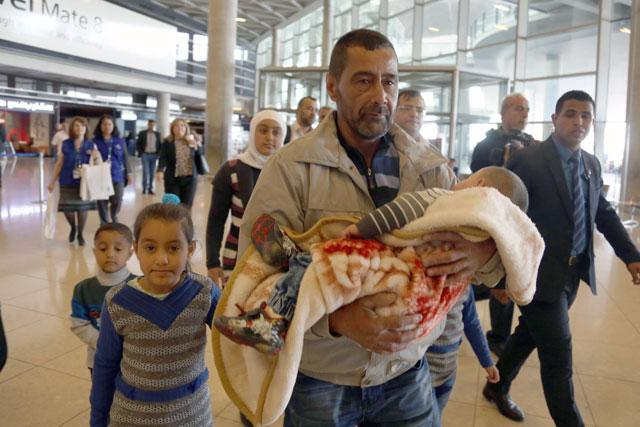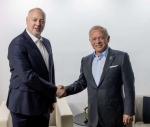You are here
First Syrian refugee family departs to US after new procedure applied
By Khetam Malkawi - Apr 07,2016 - Last updated at Apr 07,2016

A Syrian family is escorted at the airport to catch a flight to the US, where they will have a refugee status as part of a programme to host 10,000 Syrians in America, on Wednesday (Photo by Osama Aqarbeh)
AMMAN — The first Syrian refugee family, who was processed through the US recently-established temporary offsite processing centre “surge operation”, departed Amman on Wednesday to the US, with hopes that they would be able to integrate in their new community.
Although 1,000 Syrians have been already resettled in the US from Jordan, the family of seven members that left Amman on Wednesday “is the first family to depart after having been granted refugee status by our US immigration officers during our three-month resettlement surge operation that began on February 1”, said Alice G. Wells, the US ambassador to Jordan.
Last September, US President Barack Obama issued a directive ordering the admission of 10,000 Syrian refugees to the US by September 30, 2016.
To speed up the process of resettling Syrian refugees in Jordan, the US Embassy has established the temporary processing centre, which will operate until April 28, said US Embassy officials during a media tour to meet the departing family at the Queen Alia International Airport (QAIA) and to the new centre.
Ahmad (Who asked to use his first name only)along with his wife and five children said they were thankful to Jordan that hosted them for three years and he and his family are hopeful for a good life in the US, where, he hoped, his children would obtain good education.
The 45-year-old father arrived to Jordan three years ago, coming from Homs, and lived in Mafraq city, North of Amman.
“I had no work here, but was living on [food] coupons I received”, Ahmad said, adding that one of his ambitions is to find a job in the US to be able to support his family.
About his preparations to start a new life in a new destination, Ahmad said he insists on learning English and that “he is ready to integrate in the US and start a new life”.
The father of two boys and three daughters made the remarks at the QAIA in Amman, before his flight took off to Kansas City, Missouri.
“The family has suffered greatly during the Syrian conflict and I am proud that the United States is embracing this family as part of our US Refugee Admissions Programme,” Wells told the press at QAIA after meeting the family.
She added that their new life in America ensures the children a safe and secure environment to live in, and where they will receive the medical attention that they require, the education opportunities that they need to grow, and share in the dignity that they deserve.
She explained this operation (the surge), which will process 10,000 refugees by April 28, is part of “our effort to reach President Obama’s directive to send 10,000 Syrian refugees to the United States by September 30, 2016, while also ensuring that every refugee accepted by the United States has been thoroughly screened and vetted through our rigorous security process”.
Regional refugee coordinator at the US embassy in Amman, Gina Kassem, said the number announced by the president is a global number, but the very vast majority will come out of Jordan. The 10,000 is a “floor and not a ceiling, and it is possible to increase the number”, she told the press during the tour.
She said 600 refugees are interviewed on the site every day.
Kassem explained that the resettlement process normally takes 18 to 24 months from the start “when the UNHCR refers refugees to us, until the time they land at the US”.
However, after the presidential directive, the embassy established this “surge” centre.
“In three months, we will process a minimum of 10,000 refugees”, to finish by April 28. Although the processing centre will continue after this date, it will be in a normal number and in the International Organisation for Migration (IOM) locations.
As for the selection process, the official said the cases are prioritised based on vulnerability and after being referred by the UNHCR. “The US reviews the referrals, accept them in this programme to start processing.”
“We do not have exclusions or look for families with certain education background, language skills or other socioeconomic factors, and we do not cut family sizes”, Kassem stressed, noting that the IOM does not have authority on the cases, but their job is excluded to validating the information.
Related Articles
AMMAN — For Mustafa and his family, who are Syrian refugees in Jordan, a better life in the United States seemed within reach. He was c
AMMAN — Fifteen Syrian and Iraqi refugees in Jordan have been granted certificates of approval to be resettled in America under the US Refug
GENEVA — UN Secretary-General Ban Ki-moon called on countries on Wednesday to re-settle nearly half-a-million Syrian refugees in the next th














